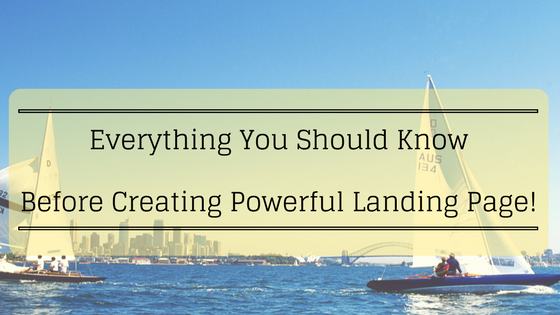Landing pages are really important part of marketing. And I can say that it’s the heart of your online marketing campaign. There are so many strategies and tactics to employ that will increase your conversions and start bringing your business the results you deserve. If you are not using landing pages then believe me you are missing out on a lot of possible conversions and new customers. But how can you start building an effective landing page? Well, if you don’t know the answer, don’t worry, because, in this article, you will get everything you have to know before creating powerful landing page that helps you achieve a higher return on investment (ROI) from your marketing spend!
Yeah, the landing page is only a part of marketing but it’s very important. Why? Because the landing page likes a tool which helps you present your products to potential customers. And now, here are 6 questions you must have the specific answers to get more targeted and efficient result from your landing page marketing strategy.
Question 1: What Are Your Business Objectives?
Why are you creating a landing page? What are you looking to get from it?
The business objective of the campaign and in particular the page. It’s important to have specific objectives or goals that you are trying to get when you decide on the marketing campaign for your landing page. For example, the goals for your landing page is capturing email addresses for future email direct marketing campaigns, so you have to design a pop-up or a banner that pays visitor’s attention. If your goal is that convincing your target market to click through to your websites shopping cart to make a purchase, so you must have a good “Call Action” button.
The more precisely you can answer this question, the more your campaign will benefit!
Question 2: Who Are Your Target Audiences?
Who will be interested in your products? What are their behaviors? Yes, you need to understand what motivates your target market to arrive at your landing page before deciding on the design. What are the main questions that a potential visitor will have? Are they looking for answers to questions? Do they want a problem solved? Or could they be seeking affirmation before purchasing your products or services? By identifying and meeting your target market’s needs, you will also achieve your business objectives.
Here are five standard demographics about your target audiences you should identify:
- Gender
- Age
- Location
- Occupation
- Income level
When you figure out who your target market is, you’ll be able to market your offer more effectively!
Question 3: What’s My Offer?
Once you define your business objectives and your target market, you can move onto what the offer on your page is. Asking yourself your conversion goal will help you figure out what exactly you’re going to be offering. You may already know what offer will complement both your business objects and your target market.
For example, I work at an Information Technology startup. We offer an online landing page design tool for everyone who doesn’t know about coding. My target market is the digital marketer who needs the landing page for their marketing campaigns. What would a marketer want from a landing page builder that would help me nurture them into a sale down the line? A resource that’s going to benefit them without selling to them (directly). Something related to how they can use online marketing to benefit their business. And most important thing here is that the marketer needs landing page for carrying out the campaigns but they don’t know how to code. And now, with the landing page builder is what they need.
Question 4: Is Your Call-To-Action Effective?
There’s nothing worse than seeing a landing page with no call-to-action. Landing pages aren’t used for brand awareness (leave that to social media). The main focus of your landing page is your call-to-action (CTA), which is what you want your audience to do. Sounds simple, but if you don’t have a very specific idea in mind, your page can lose focus. Your CTA directly relates to your business objectives and should never be vague. If your business objective is to collect email addresses for future EDM’s, your CTA could be, “sign up to our e-newsletters for industry tips and advice” which requires an email address to be provided.
Question 5: Where Are Your Entry Points?
Take note of all campaign entry points (email, organic, PPC, social media) and any existing collateral materials to ensure you maintain a consistent brand experience and design. If your landing page doesnʼt match the aesthetic of the banner ad then people will often rightfully assume they are in the wrong place and leave.
Question 6: What is Your Creative Brief?
Ideally, there will be a well-defined concept that ties business and user goals together into a simple and implementable idea. This will help you to design something that doesnʼt stray from the core goals of the campaign. If you are a small business or entrepreneur then this might seem like a bit of a luxury or an extreme waste of time. If you’ve never used a brief before, try searching for some examples or templates – it can be really useful to go through the process of creating a simple half page brief just to get the idea down on paper before you commit it to the digital realm.
Final Thought
Hopefully, by answering all of these important questions, you can start creating powerful landing page that is not only brand consistent but will also help you get more conversations!

